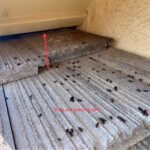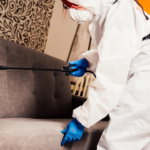5 Signs You Have a Termite Problem and How to Address It
Termites are often referred to as “silent destroyers” because they can cause significant damage to your home without you even realizing it. These tiny insects feed on wood and other cellulose-based materials, making your house a prime target for infestation. If left unchecked, termites can compromise the structural integrity of your home, leading to costly repairs. The good news is that there are telltale signs of termite activity that you can watch out for. Here are five signs you might have a termite problem and how to address it effectively.

Content
1. Wood Damage and Hollow Sounds
One of the most common signs of a termite infestation is wood damage. Termites eat wood from the inside out, leaving a thin veneer of wood or paint on the surface. As a result, wood that looks normal on the outside may be hollow or damaged on the inside.
- How to Check: Tap on wooden structures like beams, floors, or walls. If you hear a hollow sound, it could indicate that termites have eaten away the interior.
- Addressing the Issue: If you detect hollow wood, it’s crucial to have a professional termite inspection done as soon as possible. A pest control expert can assess the extent of the damage and recommend appropriate treatment options.
2. Discarded Wings Near Windows and Doors
Termites swarm in the spring and early summer as they search for new places to establish colonies. After swarming, they shed their wings, leaving behind small piles of wings near windows, doors, or other entry points.
- How to Check: Look for discarded wings around the base of windows, doors, or in spider webs. These wings are often similar in size and shape, and they are typically translucent or whitish in color.
- Addressing the Issue: Discovering discarded wings is a strong indication that termites are present. Contact a professional pest control service to conduct a thorough inspection and determine the best course of action to eliminate the infestation.
3. Mud Tubes on Exterior Walls
Subterranean termites, the most common type in the United States, build mud tubes to travel between their underground colonies and food sources. These tubes, made from soil, wood particles, and termite saliva, provide moisture and protection as termites move around.
- How to Check: Inspect the exterior foundation of your home, as well as any crawl spaces or basements, for the presence of mud tubes. These tubes are typically about the width of a pencil and can be found running along walls, foundations, or support beams.
- Addressing the Issue: If you find mud tubes, do not disturb them. Instead, contact a termite control professional immediately. They will be able to confirm the presence of termites and apply treatments that can eliminate the colony.
4. Termite Droppings (Frass)
Drywood termites create tiny, pellet-like droppings known as frass. These droppings are often found near the entry points of termites or where they are actively feeding. Frass can be one of the first visible signs of a termite problem.
- How to Check: Look for small piles of frass near windowsills, baseboards, or in attics. The droppings are often tan, brown, or black and resemble small grains of sand or coffee grounds.
- Addressing the Issue: If you spot frass in your home, it’s a clear sign of termite activity. A pest control expert should be called in to assess the situation and recommend a treatment plan that targets the termites effectively.
5. Swarmers (Flying Termites) Inside Your Home
Seeing winged termites, also known as swarmers, inside your home is a strong indication that a termite colony is active nearby. Swarmers are reproductive termites that leave their colony to establish new ones. If they find their way inside your home, it’s a sign that an infestation is close by or has already begun.
- How to Check: Keep an eye out for small, winged insects around windows, doors, or light fixtures. Swarmers are typically attracted to light, so they often congregate in these areas.
- Addressing the Issue: If you see swarmers inside your home, it’s time to act quickly. A professional termite inspection will determine whether the swarmers have established a colony inside your home and what steps need to be taken to eliminate it.
How to Address a Termite Infestation
If you’ve identified any of these signs, it’s essential to take immediate action. Here’s how to address a termite problem effectively:
- Schedule a Professional Inspection: The first step is to have a licensed pest control expert inspect your home. They will confirm whether termites are present and assess the extent of the infestation.
- Choose the Right Treatment: Depending on the severity of the infestation, your pest control professional may recommend several treatment options, including liquid termiticides, bait systems, or fumigation.
- Repair and Prevent Future Damage: Once the termites have been eliminated, it’s important to repair any damage they caused and take preventive measures. This might include treating the soil around your home, sealing cracks and entry points, and removing any wood-to-soil contact.
- Regular Monitoring: Ongoing monitoring and periodic inspections are key to preventing future infestations. Your pest control service may offer regular check-ups to ensure that your home remains termite-free.
Conclusion
Termites can cause significant damage to your home if left unchecked, but by being vigilant and recognizing the signs early, you can address the problem before it becomes severe. If you suspect a termite infestation, don’t wait—contact a professional pest control service to protect your home and peace of mind. Taking swift action now can save you from costly repairs and ensure that your home remains a safe, secure place for years to come.

I am Scott Miller and my love is writing about home improvement. I write mostly about home ideas, but also share some tips and tricks that can make your life easier when it comes to getting things done in the house.


